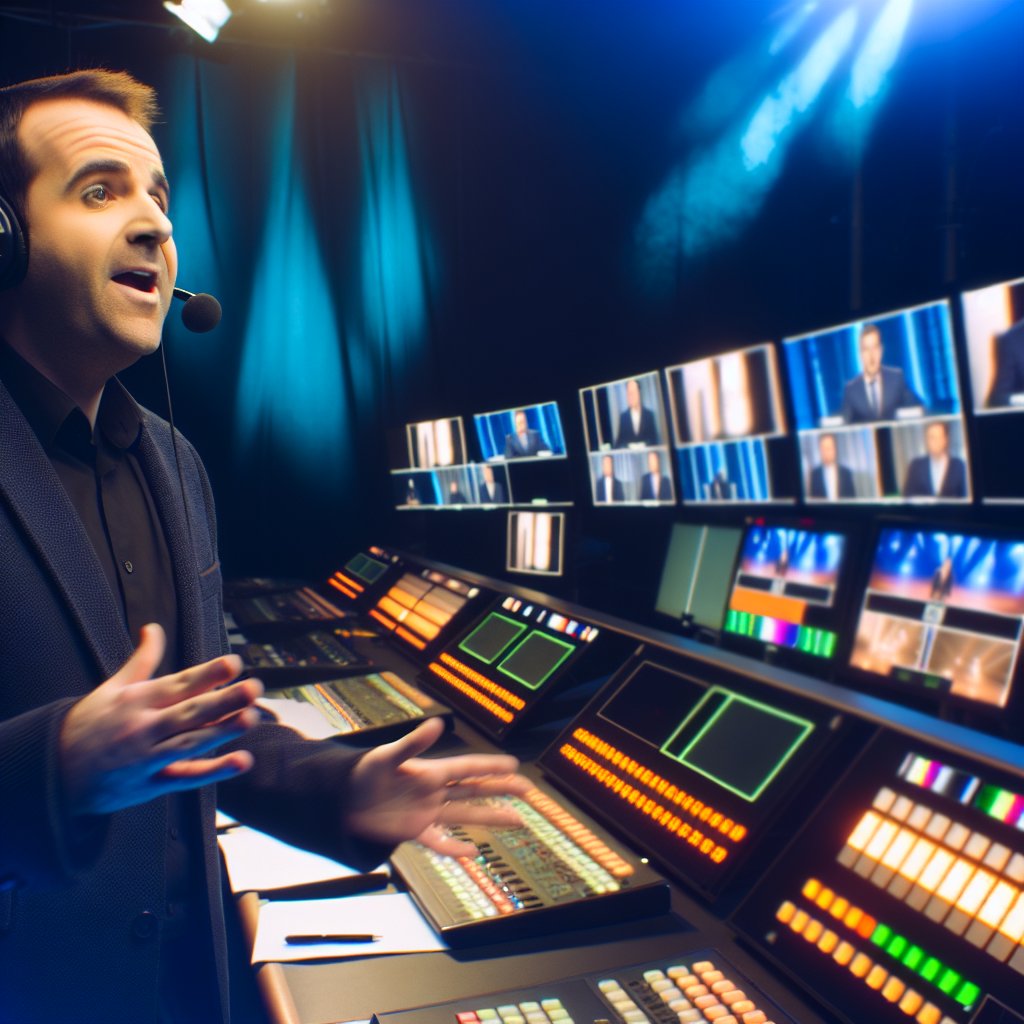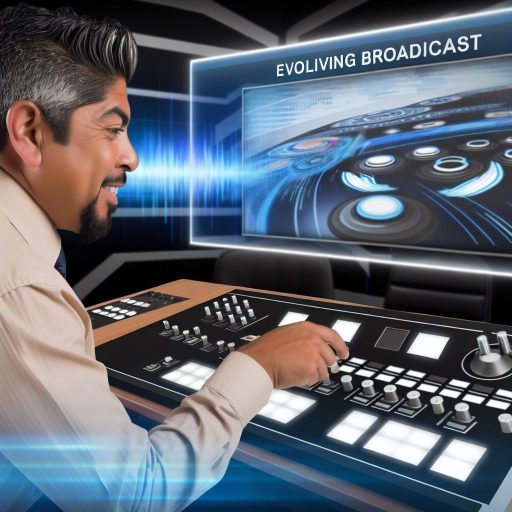Introduction
Effective communication forms the backbone of the TV production industry.
It ensures everyone involved understands their roles and responsibilities.
When team members communicate clearly, they can collaborate more efficiently.
This collaboration ultimately leads to a smooth production process.
Communication significantly contributes to the success of any TV production.
A well-informed team can adapt to changes rapidly.
Misunderstandings may lead to costly delays and mistakes, jeopardizing the entire project.
Hence, having clear channels for information flow is essential.
Regular meetings and updates keep everyone aligned with the project’s goals.
Throughout this post, we will explore key components of effective communication in TV production.
These components include clear messaging, active listening, and feedback mechanisms.
We will also discuss the role of technology in enhancing communication.
Finally, we will highlight the importance of fostering a positive communication environment.
Clear messaging serves as the foundation for effective communication.
Every team member must receive consistent information.
This prevents confusion and keeps the production on track.
Additionally, the language used should be straightforward and relatable.
Technical jargon may alienate team members who lack specific expertise.
Active listening is another vital aspect of communication.
Team members should listen attentively to ensure they grasp information fully.
Transform Your Career Today
Unlock a personalized career strategy that drives real results. Get tailored advice and a roadmap designed just for you.
Start NowThis practice fosters mutual respect and understanding among colleagues.
By valuing each other’s input, teams create a more cohesive atmosphere.
Implementing feedback mechanisms enhances the communication process.
Constructive feedback helps individuals improve their performances.
Regular check-ins allow teams to address challenges promptly.
Moreover, acknowledging good work boosts morale and encourages further collaboration.
In today’s digital landscape, technology plays a crucial role in communication.
Tools like video conferencing and instant messaging facilitate quick and efficient exchanges.
These platforms enhance collaboration, especially in remote settings.
Leveraging technology can streamline the workflow and keep the production moving smoothly.
Finally, cultivating a positive communication environment is essential.
Encouraging open dialogue creates trust among team members.
This trust allows for honest discussions and innovative ideas, ultimately leading to exceptional productions.
The Role of Communication in TV Production
Effective communication forms the backbone of successful TV production.
In this context, communication refers to the transfer of information between different teams and individuals involved in creating a TV show.
This encompasses writers, directors, producers, camera operators, and many others.
Each participant must convey ideas clearly and promptly to avoid misinterpretations.
Definition of Communication in the Context of TV Production
In the hectic environment of TV production, communication involves more than just speaking and listening.
It includes sharing thoughts, visual concepts, feedback, and instructions.
Showcase Your Business Today
Reach thousands of readers actively exploring professional services. Publish your business profile and grow your audience now.
Publish NowGood communication fosters understanding among team members.
It enables them to work toward a common vision and objective.
Effective dialogue, whether verbal or non-verbal, ensures a flow of ideas and maximizes productivity.
Enhancing Teamwork, Creativity, and Efficiency Through Communication
Communication directly influences several key aspects of TV production:
- Teamwork: Clear communication cultivates an atmosphere of collaboration.
- Creativity: Open dialogue stimulates creative thinking.
- Efficiency: Clear instructions minimize confusion and errors.
Moreover, communication enhances problem-solving.
The production process often encounters unforeseen issues.
Effective communication channels allow the team to identify problems quickly.
By addressing challenges in real-time, teams can maintain momentum.
This preparedness ultimately leads to higher quality productions.
Examples of Communication Breakdown and Its Impact on Production Quality
When communication breaks down in TV production, it can have serious repercussions.
Here are some common examples:
- Misinterpretation of Direction: If a director’s vision isn’t clearly communicated, the team may create a scene that misses the mark.
- Inadequate Feedback: Constructive feedback is crucial at all stages of production.
- Disorganized Schedules: Miscommunication regarding schedules can lead to chaos.
- Technical Failures: Poor communication about technical requirements can result in equipment malfunctions.
Each of these breakdowns underscores the importance of effective communication.
They illustrate how miscommunication can derail even the best-planned productions.
Therefore, maintaining clear lines of communication is vital for success.
Best Practices for Effective Communication in TV Production
To mitigate communication problems, teams can adopt several best practices:
- Establish Clear Channels: Defining specific channels for communication is crucial.
- Prioritize Transparency: Encourage openness in all discussions.
- Utilize Visual Aids: Visual communication can clarify complex ideas quickly.
- Conduct Regular Check-Ins: Teams should hold frequent meetings to discuss progress and issues.
- Encourage Feedback: Create a feedback culture where every team member feels comfortable giving and receiving input.
By incorporating these strategies, teams can develop a robust communication framework.
This framework helps prevent breakdowns and enhances the overall production process.
Importance of Communication in TV Production
Effective communication plays a crucial role in TV production.
It fosters teamwork, boosts creativity, and enhances efficiency.
Conversely, communication breakdowns can cripple production quality, resulting in costly consequences.
By prioritizing clear channels, transparency, and regular feedback, production teams can significantly improve their communication.
This improvement ultimately leads to higher quality productions that meet both creative and technical standards.
Types of Communication in TV Production
Verbal Communication
Effective communication begins with verbal interactions.
Clear dialogue among crew members and cast drives the production process toward success.
Strong verbal communication fosters teamwork and collaboration, vital for a television shoot.
During pre-production meetings, verbal agreements set the tone.
Directors, producers, and department heads discuss roles, responsibilities, and schedules.
Everyone must articulate their thoughts clearly to avoid misunderstandings.
Productive dialogue also includes providing feedback.
Positive reinforcement encourages team morale, while constructive criticism enhances performance.
-
Clarity: Use specific language to avoid confusion. Everyone should understand the project’s goals.
-
Respect: Maintain a respectful tone. Team members feel valued and are more likely to contribute.
-
Conciseness: Get to the point quickly. Brevity helps maintain focus during busy production days.
-
Inclusivity: Encourage input from all team members. Diverse perspectives lead to innovative ideas.
Importance of Clear Dialogue Among Crew Members and Cast
Clear dialogue is paramount in a high-pressure environment.
Crew members must understand directions promptly.
For example, a cinematographer relies on the director’s instructions to capture the desired shot.
Without clear communication, the risk of errors increases.
Actors must also receive clear guidance.
Directors communicate character intentions to help actors deliver authentic performances.
Regular check-ins during rehearsals ensure everyone is aligned with the storyline’s progress.
To further enhance verbal communication, production meetings are essential.
They facilitate open discussions and allow team members to express concerns.
Such environments nurture trust, making team members feel comfortable sharing ideas.
Showcase Your Business Today
Reach thousands of readers actively exploring professional services. Publish your business profile and grow your audience now.
Publish NowNon-Verbal Communication
Non-verbal communication encompasses body language, gestures, and visual cues.
These elements play a crucial role in the production setting.
Each gesture conveys a message, often more powerful than spoken words.
For instance, a nod signifies agreement.
On set, it can indicate understanding without disrupting the scene.
Additionally, eye contact establishes connection and attentiveness, fostering collaboration among the cast and crew.
-
Body Language: A relaxed posture encourages open communication. In contrast, closed body language can signal discomfort.
-
Facial Expressions: Smiling promotes a positive atmosphere. Frowning can indicate confusion or disagreement.
-
Gestures: Non-verbal cues, like hand signals, can streamline communication on set. They are especially useful in noisy environments.
Body Language, Gestures, and Visual Cues in a Production Setting
Understanding body language is essential for directors and crew.
Subtle cues reveal emotions that dialogue may not express.
For example, an actor’s nervous fidget can indicate discomfort with a scene.
Directors utilize gestures to communicate without words.
During rehearsals, a simple hand signal can instruct actors to reposition or adjust their delivery.
This method maintains the flow of a scene while minimizing interruptions.
Visual cues also enhance communication significantly.
For instance, colored flags can indicate lighting changes, while cue cards support actors during scenes.
Visual elements facilitate a smoother production process, ensuring everyone stays on the same page.
Written Communication
Written communication remains fundamental in TV production.
It allows for precise documentation of scripts, production notes, and essential emails.
Each written component serves a specific purpose, enhancing overall effectiveness.
The script acts as the blueprint of the production.
It lays the groundwork for dialogue, character actions, and scene descriptions.
This document guides everyone in the production team, promoting coherence and creativity.
Production notes provide invaluable insights.
These notes document important decisions made during meetings.
They also outline changes to the script or scene, ensuring everyone remains informed.
-
Emails: Clear and concise emails reinforce important messages. They serve as proof of decisions made and agreements established.
-
Call Sheets: These documents communicate daily schedules. They outline locations, cast, crew, and specific responsibilities.
-
Reports: Post-production reports summarize the production process. They highlight challenges faced and solutions developed, providing a valuable learning resource.
Use of Scripts, Production Notes, and Emails to Convey Information
Scripts must be utilized effectively.
Each team member should be familiar with their respective roles in the context of the script.
This familiarity minimizes confusion and error during filming.
Production notes require regular updates.
As the project evolves, so do its needs.
Both producers and directors must communicate changes through these notes, fostering transparency.
Emails serve as formal channels for communication.
They ensure a paper trail concerning crucial decisions.
This documentation can resolve potential conflicts and misunderstandings later on.
Find Out More: Top Industries Hiring Corporate Communications Managers
Key Teams in TV Production
Different teams bring unique skills to the table.
Understanding each team’s role is crucial for effective collaboration.
Here are the primary teams involved in television production:
- Directing Team: The director oversees the creative vision. They guide actors and communicate with other departments effectively.
- Writing Team: Writers craft the script and build the story. They must articulate ideas clearly and respond to feedback promptly.
- Cinematography Team: This team captures visuals. Cinematographers communicate technical requirements to the directing team to achieve the desired look.
- Editing Team: Editors assemble footage into a coherent narrative. They work closely with directors to meet deadlines.
- Production Team: This team handles logistics. They coordinate schedules, manage resources, and ensure that each department stays on track.
- Sound Team: This team creates the audio landscape. They collaborate with directors and editors to enhance the viewing experience.
- Art Department: Artists design the visual aspects of the show. They communicate design changes and collaborate with the directing and cinematography teams.
Communication Flow Between Teams
The communication flow between teams can make or break a production.
Each team must stay informed about the others’ progress and challenges.
This flow works best when each department understands its role and responsibilities.
Showcase Your Business Today
Reach thousands of readers actively exploring professional services. Publish your business profile and grow your audience now.
Publish Now- Regular Meetings: Daily briefings or weekly meetings foster collaboration. Team members share updates and address challenges openly.
- Project Management Tools: Using tools like Trello or Asana helps teams track progress. These platforms allow team members to assign tasks and deadlines.
- Email and Messaging Apps: Teams should use email and messaging apps to communicate quickly. This helps maintain an ongoing dialogue across departments.
- Shared Documents: Collaborative tools, like Google Docs, enable teams to share information instantly. This prevents misunderstandings and miscommunications.
- Feedback Loops: Establishing feedback channels ensures constructive criticism. Encouraging open discussions helps refine ideas and processes.
Importance of Open Lines of Communication
Maintaining open lines of communication across all departments is vital.
When teams prioritize clear communication, they foster a collaborative and productive environment.
Here are key benefits of effective communication:
- Fosters Creativity: Open dialogues allow for brainstorming and creative problem-solving. Team members feel encouraged to share innovative ideas.
- Enhances Efficiency: Clear communication reduces delays caused by misunderstandings. Each team can work confidently towards shared goals.
- Builds Trust: Transparency in communication builds trust among team members. Trust encourages collaboration and strengthens relationships.
- Facilitates Conflict Resolution: Effective communication provides a platform for addressing conflicts. Quick resolutions prevent negative impacts on production timelines.
- Improves Morale: When team members feel heard, morale soars. High morale leads to a more positive working atmosphere.
Best Practices for Effective Communication
To optimize communication within TV production, teams should adopt best practices.
- Encourage Open Dialogue: Create an environment where team members feel comfortable expressing thoughts. Listening actively fosters a culture of respect.
- Set Clear Expectations: Each team should understand their roles and responsibilities clearly. Setting expectations reduces confusion and aligns efforts.
- Use Technology Wisely: Employ communication tools that suit the team dynamic. Tailoring technology to fit needs enhances collaboration.
- Document Conversations: Keeping track of discussions and decisions helps avoid ambiguity. Well-documented meetings create reference points for future conversations.
- Provide Constructive Feedback: Encourage team members to offer feedback respectfully. Constructive criticism leads to growth and improvement.
Challenges in Communication
Despite the best efforts, challenges can arise in communication during TV production.
Identifying and addressing these challenges is essential:
- Time Constraints: Fast-paced schedules often limit communication opportunities. Teams should prioritize key discussions despite time pressures.
- Hierarchical Barriers: Often, communication flows from top to bottom. Encourage all voices to share ideas for a more inclusive environment.
- Technical Jargon: Different departments may use specialized language. Teams must strive to simplify communication for clarity.
- Remote Work Challenges: With increasing remote production, teams may struggle to communicate. Regular video conferences and check-ins mitigate isolation.
- Cultural Differences: Diversity in teams can lead to communication misunderstandings. Embracing different perspectives enriches the creative process.
Creating successful television productions hinges on effective communication among teams.
By recognizing the importance of collaboration and maintaining open lines of communication, production teams can achieve their goals.
Executing projects smoothly requires constant dialogue, adaptability, and commitment to working as one cohesive unit.
With these elements in place, television productions can shine brighter than ever.
Delve into the Subject: Adapting Communication Training for Remote Teams
Overview of Modern Tools Used in TV Production
In today’s fast-paced television production environment, effective communication plays a vital role.
Teams collaborate across multiple locations to create content.
Modern communication tools help streamline this collaboration.
They provide clear channels for dialogue among team members.
The tools used in TV production today range from simple messaging applications to advanced video conferencing software.
Each tool offers unique features that cater to the specific needs of production teams.
Here are some key tools commonly used:
- Slack: This messaging platform allows teams to communicate quickly and efficiently. It supports channels for different projects, making organization easy.
- Zoom: A popular video conferencing tool, Zoom facilitates remote meetings. It features screen sharing, which proves useful during production discussions.
- Trello: This project management tool helps track tasks and deadlines. Team members can assign tasks and monitor progress visually.
- Asana: Similar to Trello, Asana organizes tasks for production teams. It provides a clear overview of who is doing what.
- Google Workspace: Offering a suite of productivity tools, Google Workspace allows for real-time collaboration. Team members can work simultaneously on documents and spreadsheets.
Benefits of Using Technology for Remote Communication and Collaboration
The shift towards remote communication has transformed TV production in numerous ways.
With the right tools, teams can work effectively, regardless of their physical locations.
Here are some benefits of these technologies:
- Increased Flexibility: Remote tools allow team members to work from any location. This provides flexibility and accommodates different working styles and time zones.
- Real-Time Collaboration: Many tools offer real-time capabilities. This helps team members stay updated on changes and decisions as they happen.
- Cost-Effective Solutions: Remote communication tools reduce travel expenses. Teams can meet virtually instead of in person.
- Streamlined Communication: These technologies help eliminate miscommunication. Clear channels enhance message delivery among team members.
- Record Keeping: Most tools store conversation histories and documents. This allows team members to refer back to past discussions easily.
Recommended Tools for Enhancing Communication Efficiency
Selecting the right communication tools is crucial for increasing efficiency in TV production.
Below are recommended tools that help enhance communication:
- Microsoft Teams: This platform combines chat, video calls, and file sharing. It integrates seamlessly with Microsoft apps, making it ideal for teams already using Office software.
- Discord: Originally designed for gaming, Discord offers voice, video, and text communication. It’s suitable for creative teams looking for a less formal communication platform.
- Basecamp: This project management tool promotes collaborative communication. It helps keep all project-related discussions in one place.
- Miro: Miro is a visual collaboration platform. It enables teams to brainstorm, plan, and create together using interactive boards.
- Frame.io: This tool specializes in video collaboration. It allows teams to provide feedback and comments directly on video files for improved production workflows.
Implementing Communication Tools Effectively
Merely having the right tools is not enough.
Teams must implement them effectively to reap the benefits.
Here are some strategies for effective implementation:
- Training: Provide training sessions for all team members. Ensure everyone knows how to use the tools effectively.
- Set Clear Expectations: Define how and when team members should use the tools. Clarity promotes consistent usage.
- Encourage Engagement: Foster a culture of open communication. Encourage team members to engage in discussions and share updates regularly.
- Integrate Tools: Use integrations between tools to streamline processes. For example, connect Trello with Slack for task notifications.
- Solicit Feedback: Regularly ask team members for feedback on the tools. Adapt tools and processes based on their input and experiences.
Measuring Communication Effectiveness
To assess the effectiveness of communication tools, teams must track specific metrics.
Effective measurement helps identify areas for improvement.
Here are some key metrics to consider:
- Response Time: Monitor how quickly team members respond to messages and requests. Faster response times indicate effective communication.
- Engagement Levels: Track participation in discussions and meetings. Higher engagement indicates a strong communication culture.
- Project Completion Rates: Monitor the rates at which projects are completed on time. Effective communication should correlate with timely completion.
- Employee Feedback: Conduct surveys to gauge team members’ satisfaction with communication processes. Use this feedback to make improvements.
- Collaboration Frequency: Measure the frequency of collaborative tasks and meetings. Increased collaboration often signals effective communication efforts.
Tools and technologies greatly enhance effective communication in TV production.
By leveraging the right tools, teams can improve collaboration and efficiency.
As the industry evolves, adapting to new technologies will remain essential.
Teams that embrace these changes will thrive in the competitive landscape of television production.
Delve into the Subject: How to Become a Professional Translator or Interpreter

Effective communication in TV production
Effective communication is essential in the world of TV production.
Cultivating a positive communication culture strengthens collaboration.
It builds an environment where trust and openness flourish among team members.
Fostering an Environment of Trust and Openness
Creating a supportive atmosphere starts with leadership.
Leaders must model the behaviors they expect from their team.
Here are some steps to foster a culture of communication:
Showcase Your Business Today
Reach thousands of readers actively exploring professional services. Publish your business profile and grow your audience now.
Publish Now- Encourage Transparency: Share information openly within the team.
- Promote Team-Building Activities: Engage in activities that enhance relationships.
- Establish Clear Communication Channels: Define the preferred methods and tools for communication.
- Be Approachable: Leaders should create an inviting atmosphere.
- Set Clear Expectations: Clearly outline roles and responsibilities.
Trust takes time to build, but it’s vital for effective collaboration.
Encourage team members to share ideas without fear of judgment.
Support an environment where all opinions are valued.
The Importance of Active Listening and Feedback
Active listening plays a pivotal role in enhancing communication.
It ensures that all voices are heard and understood.
Here are some reasons why it matters:
- Shows Respect: Listening actively demonstrates respect for the speaker.
- Enhances Understanding: Active listening allows team members to grasp nuances.
- Encourages Engagement: When people feel listened to, they engage more fully.
- Facilitates Constructive Feedback: It enables the exchange of helpful feedback.
- Paves the Way for Conflict Resolution: Listening helps to identify underlying issues.
To practice active listening, team members should focus on the speaker.
They need to avoid distractions and refrain from interrupting.
Summarizing what others say can also enhance understanding.
Providing Constructive Feedback
Feedback is a critical component of communication in TV production.
It informs team members about their performance.
Constructive feedback is specific, actionable, and positive.
Here are some techniques for providing effective feedback:
- Be Specific: General comments don’t promote improvement.
- Focus on Behavior, Not Personality: Address actions rather than personal attributes.
- Encourage Two-Way Communication: Invite team members to share their thoughts.
- Timing Matters: Provide feedback soon after an event.
- Celebrate Successes: Acknowledge and celebrate achievements.
Techniques for Resolving Conflicts and Misunderstandings
Conflicts and misunderstandings can arise in collaborative environments.
Addressing these issues promptly maintains harmony within the team.
To effectively resolve conflicts, consider these techniques:
- Identify the Root Cause: Look beyond surface-level disagreements.
- Encourage Open Dialogue: Create a safe space for discussion.
- Focus on Solutions: Shift the focus from blame to problem-solving.
- Seek Compromise: Encourage team members to find middle ground.
- Involve a Mediator: In cases of prolonged conflict, consider bringing in an unbiased third party.
When conflicts get resolved positively, the entire team benefits.
Teams grow stronger and more united after addressing challenges.
They learn to communicate more effectively in future interactions.
Cultivating a Positive Communication Culture
Cultivating a positive communication culture in TV production is non-negotiable.
Trust and openness among team members lead to greater collaboration.
Active listening, constructive feedback, and conflict resolution techniques are essential tools.
When utilized properly, these strategies create an environment where creativity thrives.
In such a culture, every voice matters, and effective communication becomes the norm.
By implementing these steps, production teams can enhance their communication.
As a result, they will navigate challenges with confidence.
Working together effectively will lead to successful productions that engage and inspire audiences.
Explore Further: Broadcast Technician: Essential Soft Skills
The Necessity of Training Programs for Team Members
Effective communication serves as the backbone of successful TV production.
It enhances collaboration among team members and improves the overall production process.
Training programs specifically designed to enhance communication skills are essential.
They equip team members with tools to convey ideas clearly and effectively.
Consider the complexity of a TV production.
Multiple departments, including scriptwriting, directing, camera work, and editing, need to collaborate seamlessly.
Each team needs to understand its role while effectively communicating with one another.
A lack of communication can cause misunderstandings, delays, and even conflicts.
Training programs can significantly reduce these risks.
They ensure that every member of the production team understands the importance of their role and how to communicate effectively.
Such programs foster a sense of community and teamwork, which are crucial in a high-pressure environment like TV production.
Examples of Communication Skills Workshops and Exercises
Implementing targeted workshops and exercises can significantly improve communication skills among team members.
Showcase Your Business Today
Reach thousands of readers actively exploring professional services. Publish your business profile and grow your audience now.
Publish NowSeveral effective formats exist, such as:
- Team-building exercises: Activities like trust falls and obstacle courses promote collaboration.
- Role-playing scenarios: These help participants practice responses in common production situations.
- Feedback sessions: Encourage constructive criticism among team members to foster open communication.
- Conflict resolution workshops: Equip teams with skills to handle disagreements effectively.
- Public speaking training: Boost confidence in expressing ideas in front of the team.
Each of these formats allows team members to practice their communication skills in a safe environment.
Team-building exercises create rapport, while role-playing sharpens problem-solving skills.
In addition, feedback sessions lead to enhanced mutual understanding.
Conflict resolution workshops enable smoother navigation through differences, lowering tensions and improving outcomes.
Impact of Continuous Learning on Team Dynamics and Production Outcomes
Continuous learning greatly enhances team dynamics.
Communication skills training does not end after a single workshop.
Ongoing development is vital for adapting to the fast-paced nature of TV production.
Here are some benefits of continuous learning:
- Improved Collaboration: Regular training sessions encourage dialogue and cooperation.
- Enhanced Creativity: Open communication allows for idea sharing and innovation.
- Increased Confidence: Team members who practice regularly gain assurance in their abilities.
- Better Problem-Solving: Training equips teams to tackle challenges head-on.
- Stronger Relationships: Ongoing interactions build trust among team members.
Continuous learning fosters an adaptive and dynamic work environment.
In the ever-changing world of television, production teams must adapt rapidly to new challenges.
Regular training allows teams to pivot, ensuring that communication remains effective over time.
It transforms the production environment, creating a culture grounded in collaboration, respect, and understanding.
Furthermore, investing in employees’ communication skills positively impacts production outcomes.
Projects with well-communicating teams often finish on time and within budget.
They produce higher-quality results because team members work harmoniously towards a unified vision.
Details do not get lost in translation, and every department functions smoothly.
In contrast, poorly communicating teams often produce subpar content, missed deadlines, and disengaged employees.
Implementing training programs focused on communication skills is crucial for any TV production team.
The necessity for these programs stems from the need to overcome the complexities involved in collaboration.
By participating in practical workshops and exercises, team members can enhance their ability to work together effectively.
Continuous learning not only improves team dynamics but also boosts the overall quality of production outcomes.
Importance of Investing in Communication Skills
As the landscape of television production evolves, the importance of effective communication will only grow.
Investing in training programs for communication skills is no longer optional; it’s vital.
Those teams that prioritize communication will excel, creating engaging content and fostering strong interpersonal relationships.
Dedicated training and development in communication skills prepare teams for success.
They ensure that every team member is heard, valued, and empowered.
In turn, this creates a productive, positive work environment that benefits everyone involved.
It’s time for production teams to embrace this challenge and commit to becoming exceptional communicators.
Importance of Effective Communication in TV Production
Effective communication stands as a cornerstone in TV production.
It fosters collaboration and creativity among teams.
Clear dialogue enhances productivity and mitigates misunderstandings.
Each department relies on precise communication to fulfill its role.
Directors, producers, and crew must align their visions seamlessly.
In the fast-paced world of television, time is often limited.
Miscommunication can cause delays and escalate costs.
When everyone understands their tasks, projects flow smoothly.
This clarity cultivates a positive working environment.
Team members feel empowered, leading to greater job satisfaction and retention.
Investing in communication practices significantly elevates production quality.
Showcase Your Business Today
Reach thousands of readers actively exploring professional services. Publish your business profile and grow your audience now.
Publish NowTools like regular updates, feedback sessions, and clear protocols contribute to success.
For instance, daily briefings keep everyone on the same page.
They allow teams to address challenges promptly and develop solutions collectively.
Furthermore, technology plays a vital role in streamlining communication.
Utilizing project management software and messaging apps enhances coordination.
These tools provide instant feedback and reduce information silos.
With everyone connected, creative ideas can flourish without barriers.
As we reflect on the importance of effective communication, let’s consider its role in fostering innovation.
When professionals share ideas openly, they inspire one another.
This exchange of concepts leads to groundbreaking television moments.
Invest in refining your communication strategies to realize this potential.
We urge all professionals in the industry to prioritize communication.
Assess current practices and identify areas for improvement.
Training sessions in communication skills can prove invaluable.
Nurture a culture that values clarity, collaboration, and respect.
Your commitment will enhance not only production quality but also team morale.
Embrace the challenge today.
Transform your communication strategies for better outcomes in TV production.
The industry’s future depends on how well we connect and collaborate.
Let’s elevate our productions through effective communication!
Additional Resources
Media, Journalism and Film | The Cathy Hughes School of …
School of Social Sciences, Communication & Humanities | Endicott …
[E-Books for Sale]
The Big Book of 500 High-Paying Jobs in America: Unlock Your Earning Potential
$19.99 • 500 High-Paying Jobs • 330 pages
Explore 500 high-paying jobs in America and learn how to boost your career, earn more, and achieve success!
See All 500 High-Paying Jobs of this E-Book
1001 Professions Without a Degree: High-Paying American Jobs You Can Start Now
$19.99 • 1001 Professions Without a Degree • 174 pages
Discover 1001 high-paying jobs without a degree! Unlock career tips, skills, and success strategies for just $19.99!




